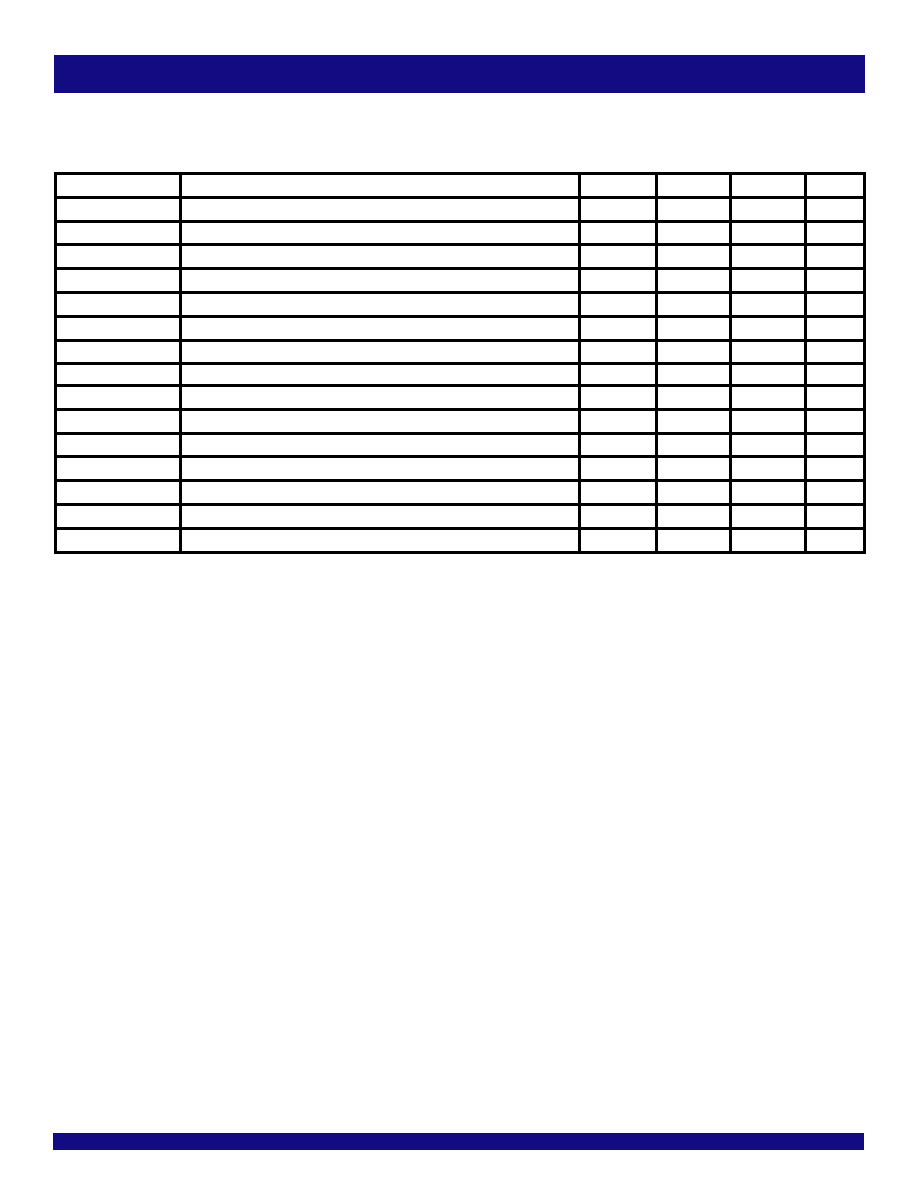- 您现在的位置:买卖IC网 > Sheet目录2000 > IDTCV133PAG (IDT, Integrated Device Technology Inc)IC FLEXPC CLK PROGR P4 56-TSSOP

COMMERCIALTEMPERATURERANGE
IDTCV133
PROGRAMMABLEFLEXPCCLOCKFORP4PROCESSOR
21
Symbol
Parameter
Min.
Typ.
Max.
Unit
tR1
Clock Rise Time(1,2,3)
175
—
700
ps
tF1
Clock Fall Time(1,2,3)
175
—
700
ps
Δ tR
Clock Rise Time Variation(2,3,4)
—
125
ps
Δ tF
Clock Fall Time Variation(2,3,4)
—
125
ps
Rise/Fall Matching(2,3,5)
——
20
%
VHIGH
Voltage HIGH(2,3,6)
660
700
850
mV
VLOW
Voltage LOW (2,3,7)
-150
0
—
mV
VCROSS(ABS)
Crossing Voltage (abs)(2,3,8,9,10)
250
—
550
mV
VCROSS(REL)
Crossing Voltage (rel)(2,3,10,11)
Calc.
—
Calc.
TOTAL
Δ VCROSS
Total Variation of VCROSS Over All Edges(2,3,12)
—
140
mV
tJCYC-CYC
Cycle-to-Cycle Jitter(2,13)
—
350
ps
dT3
Duty Cycle(2,13)
45
—
55
%
VOVS
Maximum Voltage Allowed at Output (overshoot)(2,3,14)
——
VHIGH + 0.3V
V
VUDS
Minimum Voltage Allowed at Output (undershoot)(2,3,15)
-0.3
—
V
VRB
Ringback Margin(2,3)
n/a
—
0.2
V
LVDS AC TIMING REQUIREMENTS
Following Conditions Apply Unless Otherwise Specified:
Operating Condition: TA = 0°C to +70°C
NOTES:
1.
Measured from VOL = 1.75V to VOH =0.525V. Only valid for Rising LVDS and Falling LVDS#. Signal must be monotonic through the VOL to VOH region for tRISE and tFALL.
2.
Test configuration is Rs = 32.2
Ω, Rp = 49.9Ω, 2pF.
3.
Measurement taken from single-ended waveform.
4.
Measured with oscilloscope, averaging off, using Min. Max. statistics. Variation is the delta between Min. and Max.
5.
Measured with oscilloscope, averaging off, the difference between the tRISE (average) of LVDS versus the tFALL (average) of LVDS#.
6.
VHIGH is defined as the statistical average HIGH value as obtained by using the oscilloscope VHIGH math function.
7.
VLOW is defined as the statistical average LOW value as obtained by using the oscilloscope VLOW math function.
8.
Measured at crossing point where the instantaneous voltage value of the rising edge of LVDS equals the falling edge of LVDS#.
9.
This measurement refers to the total variation from the lowest crossing point to the highest, regardless of which edge is crossing.
10. The crossing point must meet the absolute and relative crossing point specifications simultaniously.
11. VCROSS (rel) Min. and Max. are derived using the following: VCROSS (rel) Min. = 0.25V + 0.5 (VHAVG - 0.7V), VCROSS (rel) Max. = 0.55V + 0.5 (0.7V - VHAVG).
12.
Δ VCROSS is defined as the total variation of all crossing voltages of Rising LVDS and Falling LVDS#. This is the maximum allowed variance in VCROSS for any particular system.
13. Measurement is taken from differential waveform.
14. Overshoot is defined as the absolute value of the maximum voltage.
15. Undershoot is defined as the absolute value of the minimum voltage.
发布紧急采购,3分钟左右您将得到回复。
相关PDF资料
IDTCV136PAG
IC FLEXPC CLK ATI RS400 56-TSSOP
IDTCV137PAG
IC FLEXPC CLK AMD K8 56-TSSOP
IDTCV142PAG
IC FLEXPC CLK PROGR P4 56-TSSOP
IDTCV146PVG
IC FLEXPC CLK PROGR P4 56-SSOP
IDTCV149PAG
IC FLEXPC CLK PROGR K8 56-TSSOP
IDTNW6005ASG
IC CALLER ID DECODER 20SOIC
IDTNW6006AS
IC CALLER ID DECODER 20-SOIC
IDTSSTE32882HLBBKG
IC REGISTERING CLK DRIVER 176BGA
相关代理商/技术参数
IDTCV133PAG8
功能描述:IC FLEXPC CLK PROGR P4 56-TSSOP RoHS:是 类别:集成电路 (IC) >> 时钟/计时 - 专用 系列:FlexPC™ 标准包装:28 系列:- 类型:时钟/频率发生器 PLL:是 主要目的:Intel CPU 服务器 输入:时钟 输出:LVCMOS 电路数:1 比率 - 输入:输出:3:22 差分 - 输入:输出:无/是 频率 - 最大:400MHz 电源电压:3.135 V ~ 3.465 V 工作温度:0°C ~ 85°C 安装类型:表面贴装 封装/外壳:64-TFSOP (0.240",6.10mm 宽) 供应商设备封装:64-TSSOP 包装:管件
IDTCV136PAG
功能描述:IC FLEXPC CLK ATI RS400 56-TSSOP RoHS:是 类别:集成电路 (IC) >> 时钟/计时 - 专用 系列:FlexPC™, PCI Express® (PCIe) 标准包装:1,500 系列:- 类型:时钟缓冲器/驱动器 PLL:是 主要目的:- 输入:- 输出:- 电路数:- 比率 - 输入:输出:- 差分 - 输入:输出:- 频率 - 最大:- 电源电压:3.3V 工作温度:0°C ~ 70°C 安装类型:表面贴装 封装/外壳:28-SSOP(0.209",5.30mm 宽) 供应商设备封装:28-SSOP 包装:带卷 (TR) 其它名称:93786AFT
IDTCV136PAG8
功能描述:IC FLEXPC CLK ATI RS400 56-TSSOP RoHS:是 类别:集成电路 (IC) >> 时钟/计时 - 专用 系列:FlexPC™, PCI Express® (PCIe) 标准包装:28 系列:- 类型:时钟/频率发生器 PLL:是 主要目的:Intel CPU 服务器 输入:时钟 输出:LVCMOS 电路数:1 比率 - 输入:输出:3:22 差分 - 输入:输出:无/是 频率 - 最大:400MHz 电源电压:3.135 V ~ 3.465 V 工作温度:0°C ~ 85°C 安装类型:表面贴装 封装/外壳:64-TFSOP (0.240",6.10mm 宽) 供应商设备封装:64-TSSOP 包装:管件
IDTCV137PAG
功能描述:IC FLEXPC CLK AMD K8 56-TSSOP RoHS:是 类别:集成电路 (IC) >> 时钟/计时 - 专用 系列:FlexPC™, PCI Express® (PCIe) 标准包装:1,500 系列:- 类型:时钟缓冲器/驱动器 PLL:是 主要目的:- 输入:- 输出:- 电路数:- 比率 - 输入:输出:- 差分 - 输入:输出:- 频率 - 最大:- 电源电压:3.3V 工作温度:0°C ~ 70°C 安装类型:表面贴装 封装/外壳:28-SSOP(0.209",5.30mm 宽) 供应商设备封装:28-SSOP 包装:带卷 (TR) 其它名称:93786AFT
IDTCV137PAG8
功能描述:IC FLEXPC CLK AMD K8 56-TSSOP RoHS:是 类别:集成电路 (IC) >> 时钟/计时 - 专用 系列:FlexPC™, PCI Express® (PCIe) 标准包装:28 系列:- 类型:时钟/频率发生器 PLL:是 主要目的:Intel CPU 服务器 输入:时钟 输出:LVCMOS 电路数:1 比率 - 输入:输出:3:22 差分 - 输入:输出:无/是 频率 - 最大:400MHz 电源电压:3.135 V ~ 3.465 V 工作温度:0°C ~ 85°C 安装类型:表面贴装 封装/外壳:64-TFSOP (0.240",6.10mm 宽) 供应商设备封装:64-TSSOP 包装:管件
IDTCV140
制造商:IDT 制造商全称:Integrated Device Technology 功能描述:PROGRAMMABLE FLEXPC CLOCK FOR P4 PROCESSOR
IDTCV141PAG
功能描述:IC CLK BUFFER 1-8 DIFF 48-TSSOP RoHS:是 类别:集成电路 (IC) >> 时钟/计时 - 专用 系列:- 标准包装:1 系列:- 类型:时钟/频率发生器,多路复用器 PLL:是 主要目的:存储器,RDRAM 输入:晶体 输出:LVCMOS 电路数:1 比率 - 输入:输出:1:2 差分 - 输入:输出:无/是 频率 - 最大:400MHz 电源电压:3 V ~ 3.6 V 工作温度:0°C ~ 85°C 安装类型:表面贴装 封装/外壳:16-TSSOP(0.173",4.40mm 宽) 供应商设备封装:16-TSSOP 包装:Digi-Reel® 其它名称:296-6719-6
IDTCV141PAG8
功能描述:IC CLK BUFFER 1-8 DIFF 48-TSSOP RoHS:是 类别:集成电路 (IC) >> 时钟/计时 - 专用 系列:- 标准包装:28 系列:- 类型:时钟/频率发生器 PLL:是 主要目的:Intel CPU 服务器 输入:时钟 输出:LVCMOS 电路数:1 比率 - 输入:输出:3:22 差分 - 输入:输出:无/是 频率 - 最大:400MHz 电源电压:3.135 V ~ 3.465 V 工作温度:0°C ~ 85°C 安装类型:表面贴装 封装/外壳:64-TFSOP (0.240",6.10mm 宽) 供应商设备封装:64-TSSOP 包装:管件